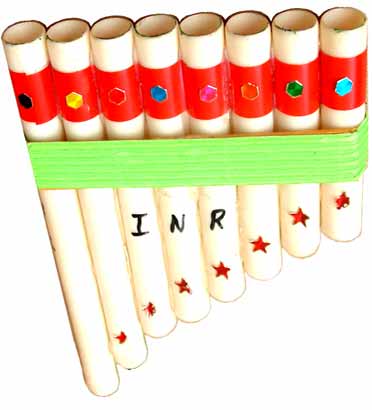|
|
 |
PAN-PIPES
ONCE UPON A TIME...
PAN-PIPES, of the sort played in the past by the knife-grinders as they went about their rounds, are an instrument with a long tradition in Portugal. The knife-grinder used to announce his presence in the street by playing his pipes, running up and down the musical scale from the lowest to the highest note and back again, with a few fancy flourishes in the middle. This was the way in which people used to advertise themselves at that time. Because not only did this man sharpen knives and scissors and mend pans, but he also used to fix umbrellas. Whenever they heard the sound of his PAN-PIPES being played some distance away, the villagers would say... it’s going to ram! It is a very old instrument. Even the Romans and Greeks used to make these pipes and play them and they’re still found all over the world today. In Burma, where they’re known as “NAURE”, they’re one of the most important popular instruments, whilst in Peru there are PAN-PIPES that are as much as 2 meters high. To avoid having to buy a stepladder, you’d be better off making yours much smaller.
MATERIAL NEEDED
A meter of PVC tubing, 8 corks stoppers, roughly 20 cm of cane and 2 meters of woolen thread.
TOOLS AND ACCESSORIES
A hacksaw, a blunt metal file, a penknife and some sandpaper (Nş. 150).
HOW TO MAKE THE INSTRUMENT
Canes are the ideal material for making this instrument. In Portugal, though, it’s actually quite difficult to find the right sort of canes for this job. The alternative that 1 suggest is to use plastic tubing. To begin with, cut the tube into 8 pieces of different lengths. When you’re making your cuts, don’t forget to be careful with the saw. The biggest tubes produce the deepest sounds and the smaller ones produce the high pitched sounds. To get a nice clear sound, the tubes should all be completely sealed at one end. The lengths of the eight tubes should be as follows: 16.5, 15, 14, 13, 12, 11, 10 and 9 cm. The cutting operation must be followed by rounding off the edges of the tube with the file and then smoothing them down with the sandpaper, since when you play this flute, you’ll have to place the tube against your lips, and if the edges are rough you could end up hurting yourself. Now place a cork in each of the tubes. Ask your music teacher to help you tune these notes correctly. The pipes are tuned by moving the cork up or down inside the tube: after you’ve got the 8 notes tuned to your liking, you should tie the pipes together using cane strips and string or woolen thread.
DECORATION
Tying up the tubes with different colour threads gives your PAN-PIPES a nice bright look. But the real happiness will come when you start playing your own tunes. There’s an old Chinese proverb that says, when there’s music in the house, the family is happy and at peace.
HOW TO PLAY THE INSTRUMENT
At first, playing the pipes might seem complicated, but you’ll soon get the hang of it. Place your lips against just one of the pipes and blow hard. First, begin by playing ascending scales (do, re, mi, fa, sol, la, si, doo) and then descend scales (from the high to the low notes). After a few days, you should be able to play the odd tune. Learning to play these pipes means practicing every day, because nobody is born having already been taught what to do. While we’re on the subject of teaching: don’t forget to teach your friends how to make a set of PAN-PIPES, as soon as your own is ready. If it’s true that unity is strength, then you and your friends should make a whole series of pipes.
